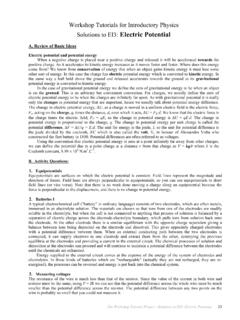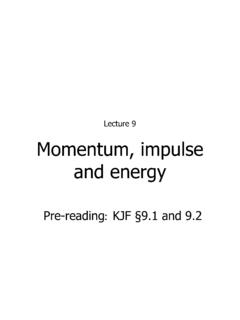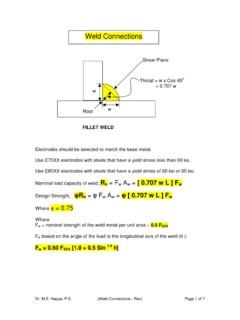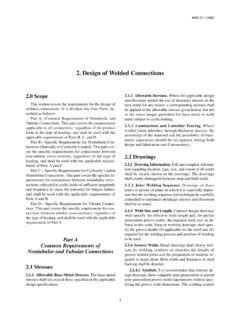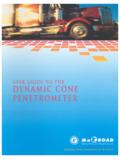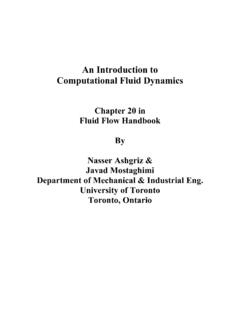Transcription of Superconductivity
1 Figure 1. The resistance of mercury measured by Onnes. Superconductivity by Joe Khachan and Stephen Bosi The discovery of superconductors The phenomenon of Superconductivity , in which the electrical resistance of certain materials completely vanishes at low temperatures, is one of the most interesting and sophisticated in condensed matter physics. It was first discovered by the Dutch physicist Heike Kamerlingh Onnes, who was the first to liquefy helium (which boils at Kelvin at standard pressure). In 1911 Kamerlingh Onnes and one of his assistants discovered the phenomenon of Superconductivity while studying the resistance of metals at low temperatures. They studied mercury because very pure samples could easily be prepared by distillation.
2 The historic measurement of Superconductivity in mercury is shown in Figure 1. As in many other metals, the electrical resistance of mercury decreased steadily upon cooling, but dropped suddenly at K, and became undetectably small. Soon after this discovery, many other elemental metals were found to exhibit zero resistance when their temperatures were lowered below a certain characteristic temperature of the material, called the critical temperature, Tc, some of which are given in Figure 2. The Meissner effect In 1933, Walter Meissner and Robert Ochsenfeld discovered a magnetic phenomenon that showed that superconductors are not just perfect conductors. Figure 3 illustrates a thought experiment that highlights this difference.
3 Imagine that both the ideal conductor and superconductor are above their critical temperature, Tc. That is, they both are in a normal conducting state and have electrical resistance. A magnetic field, Ba, is then applied. This results in the field penetrating both materials. Both samples are then cooled so that the ideal conductor now has zero resistance. It is found that the superconductor expels the magnetic field from inside it, while the ideal conductor maintains its interior field. Note that energy is needed by the superconductor to expel the magnetic field. This energy comes from the exothermic superconducting transition. Switching off the field induces currents in the ideal conductor that prevent Figure 2.
4 The critical temperatures of some superconductors. changes in the magnetic field inside it by Lenz s law. However, the superconductor returns to its initial state, no magnetic field inside or outside it. Type I and II superconductors High magnetic fields destroy Superconductivity and restore the normal conducting state. Depending on the character of this transition, we may distinguish between type I and II superconductors. The graph shown in Figure 4 illustrates the internal magnetic field strength, Bi, with increasing applied magnetic field. It is found that the internal field is zero (as expected from the Meissner effect) until a critical magnetic field, Bc, is reached where a sudden transition to the normal state occurs.
5 This results in the penetration of the applied field into the interior. Superconductors that undergo this abrupt transition to the normal state above a critical magnetic field are known as type I superconductors. Most of the pure elements in Figure 2 tend to be type I superconductors. Type II superconductors, on the other hand, respond differently to an applied magnetic field, as shown in Figure 5. An increasing field from zero results in two critical fields, Bc1 and Bc2. At Bc1 the applied field begins to partially penetrate the interior of the superconductor. However, the Superconductivity is maintained at this point. The Superconductivity vanishes above the second, much higher, critical field, Bc2.
6 For applied fields between Bc1 and Bc2, the applied field is able to partially penetrate the superconductor, so the Meissner effect is incomplete, allowing the superconductor to tolerate very high magnetic fields. Figure 3. The Meissner effect. Figure 4. Type-I superconductor behaviour. Figure 5. Type-II superconductor behaviour. Type II superconductors are the most technologically useful because the second critical field can be quite high, enabling high field electromagnets to be made out of superconducting wire. Most compounds shown in Figure 2 are type-II superconductors. Wires made from say niobium-tin (Nb3Sn) have a Bc2 as high as Tesla in practice it is lower.
7 This makes them useful for applications requiring high magnetic fields, such as Magnetic Resonance Imaging (MRI) machines. The advantage of using superconducting electromagnets is that the current only has to be applied once to the wires, which are then formed into a closed loop and allow the current (and field) to persist indefinitely as long as the superconductor stays below the critical temperature. That is, the external power supply can be switched off. As a comparison, the strongest permanent magnets today may be able to produce a field close to 1 Tesla. However, it is possible to obtain up to Tesla from a niobium tin superconductor.
8 There is a misconception amongst some non-specialists that the term "Type II" refers to the copper oxide based high temperature superconductors discovered in the late 1980s. While these are type II superconductors, so are many superconductors discovered before that time. Why is a levitated magnet stable? A common demonstration of the Meissner effect is to cool a high Tc superconductor (YBa2Cu3O7), then place a small and strong permanent magnet on top of it to demonstrate the repulsion of the magnetic field by the superconductor as shown in Figure 6. This repulsion results in the levitation of the magnet. An explanation for this levitation is that the magnet sees a mirror image of itself in the superconductor, which is like a magnet floating on top of another identical magnet.
9 This would be true if the superconductor was much larger than the magnet. In practice the superconductor may be only slightly larger than the magnet. This will result in a distorted image of the magnet, especially near the edges of the superconductor. The situation then is similar to trying to balance two magnets on top of each other. If you have ever tried to balance one magnet on top of another, you would have quickly found that it is impossible to do without physically holding it there. Left alone, the magnet will always topple over and never stay levitated. This is a well known effect in physics, a consequence of Earnshaw s theorem, which states that there can never be any stable configuration of magnetic fields that will trap another magnet.
10 Figure 6. Levitating permanent magnet on top of a high Tc superconductor. So why does a levitating permanent magnet remain stable on top of a small sized superconductor? Even a little nudge causes the magnet to spring back to its original position as if somehow tied by invisible springs to that point. To explain this, we need to expose everyone s little secret when they demonstrate this levitation experiment. If the magnet is lightly placed over a newly cooled high temperature superconductor, you should find that the magnet does not stay levitated for long. It slips off very quickly as one would expect to happen if a magnet is placed on top of another magnet, or a distorted mirror image of itself in this case.
